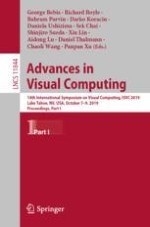2019 | Buch
Advances in Visual Computing
14th International Symposium on Visual Computing, ISVC 2019, Lake Tahoe, NV, USA, October 7–9, 2019, Proceedings, Part I
herausgegeben von: George Bebis, Richard Boyle, Bahram Parvin, Darko Koracin, Daniela Ushizima, Sek Chai, Shinjiro Sueda, Xin Lin, Aidong Lu, Daniel Thalmann, Chaoli Wang, Panpan Xu
Verlag: Springer International Publishing
Buchreihe : Lecture Notes in Computer Science
